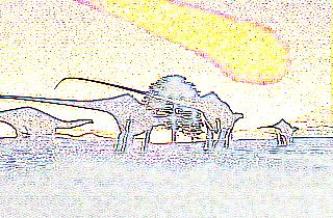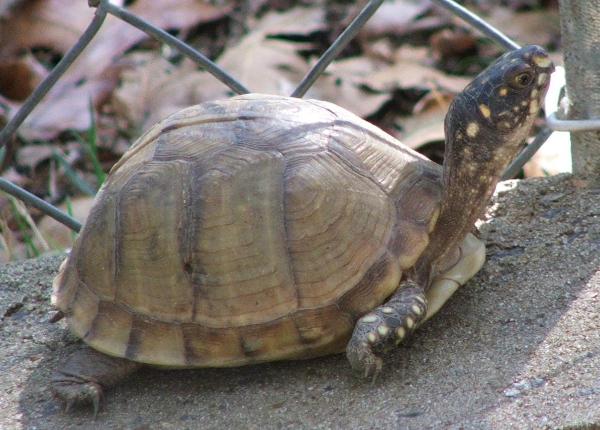DINOSAUR EXTINCTION THEORY |

| One popular theory for dinosaur extinction suggests that a 10 kilometer diameter asteroid impacted 65 million years ago in the northwestern part of the Yucatan Peninsula in Mexico. The impact of this extraterrestrial object threw up enough dust into the upper atmosphere to cause a climate change resulting in a breakdown of the food chain and ultimately the death of the dinosaurs. Molten rock, ejected from the impact, started massive firestorms which raged across the planet pumping huge amounts of smoke and ash into the air and blocking out sunlight. Geological evidence for this theory is present worldwide in a very thin layer of clay in the rock strata corresponding in time to dinosaur extinction. It is called the "K-T boundary" and dinosaur fossils are found in the layers below the "K-T boundary" but not above it. The K-T clay contains soot from fires and is rich in the rare earth element of Iridium which is plentiful in asteroid material. The impact of this size meteorite would have started a catastrophic chain reaction of events, firstly, a shock wave of hot high speed winds from the blast, followed by earthquakes, tidal waves, volcanic eruptions and global fires. Winds would have spread the cloud of debris causing worldwide darkness and a drop in temperatures. After a few months of darkness, carbon dioxide from the global fires would have caused an increase in temperature and acid rain. Only a few small, rugged species of life, such as crocodiles and turtles, were able to survive this event.- (see below) The Yucatan impact, Tunguska fireball and the Barringer meteor crater in Arizona USA, prove that earth is impacted by large objects from time to time. It's not a question "IF" such an object will collide with earth again, only the question of "WHEN" it will hit. If this doomsday object is detected early enough, perhaps the power of space science can nudge it off course and save life on earth from another dinosaur type of extinction. If successful, this space mission alone would be worth every penny that has been spent on space research. |
| Meet Tripod, a three legged box shell turtle who once lived in my garden. Tripod enjoyed earthworms, crickets, bananas, dog food and kitchen scraps. A rugged species, changing little over 65 million years, her type once walked with, and was stepped on, by dinosaurs. Unfortunately, turtles don't do well in modern times because many are killed on roadways. I rescued Tripod after she lost her left rear foot due to a passing car. Fully recovered from her injury, I recently set her free within a wildlife refuge, far away from any roads. I'm protective of all wildlife and I always move turtles off roads when it can be safely done. The Box Shell turtle (more correctly called tortoise) is a land dweller, a gentle, timid creature that will usually draw up into its shell when approached. I was lucky to have captured the photo above. Note- Box Shells, like Tripod, are safe to handle and will not bite, even if they are provoked. However, some species of water turtle are very aggressive, like the snapping turtle which strikes at you fast and it has a long reach with neck length equal to shell length. So, BE WARNED, know in advance what you're handling !!! Check the WWW for more information. |
